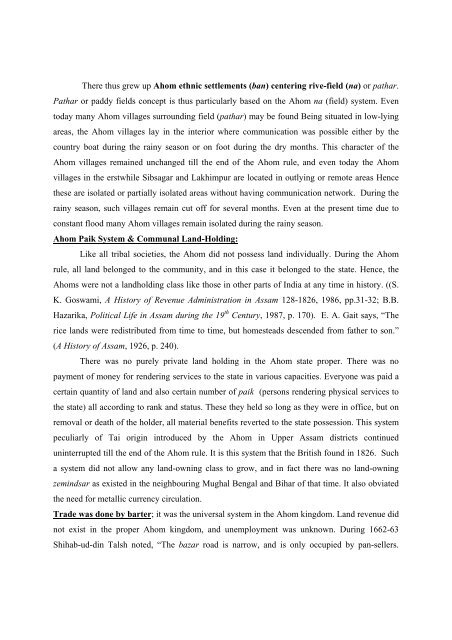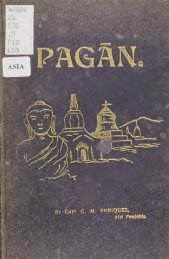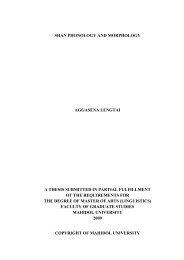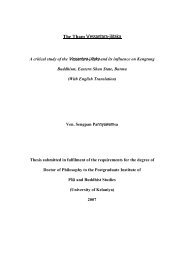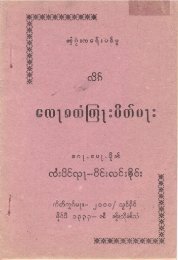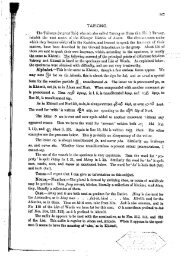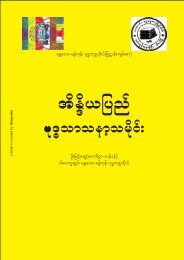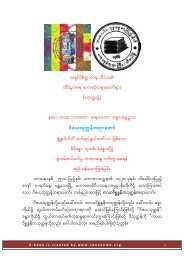The Tai Ahom National Council Memo Scheduling
The Tai Ahom National Council Memo Scheduling
The Tai Ahom National Council Memo Scheduling
Create successful ePaper yourself
Turn your PDF publications into a flip-book with our unique Google optimized e-Paper software.
<strong>The</strong>re thus grew up <strong>Ahom</strong> ethnic settlements (ban) centering rive-field (na) or pathar.<br />
Pathar or paddy fields concept is thus particularly based on the <strong>Ahom</strong> na (field) system. Even<br />
today many <strong>Ahom</strong> villages surrounding field (pathar) may be found Being situated in low-lying<br />
areas, the <strong>Ahom</strong> villages lay in the interior where communication was possible either by the<br />
country boat during the rainy season or on foot during the dry months. This character of the<br />
<strong>Ahom</strong> villages remained unchanged till the end of the <strong>Ahom</strong> rule, and even today the <strong>Ahom</strong><br />
villages in the erstwhile Sibsagar and Lakhimpur are located in outlying or remote areas Hence<br />
these are isolated or partially isolated areas without having communication network. During the<br />
rainy season, such villages remain cut off for several months. Even at the present time due to<br />
constant flood many <strong>Ahom</strong> villages remain isolated during the rainy season.<br />
<strong>Ahom</strong> Paik System & Communal Land-Holding:<br />
Like all tribal societies, the <strong>Ahom</strong> did not possess land individually. During the <strong>Ahom</strong><br />
rule, all land belonged to the community, and in this case it belonged to the state. Hence, the<br />
<strong>Ahom</strong>s were not a landholding class like those in other parts of India at any time in history. ((S.<br />
K. Goswami, A History of Revenue Administration in Assam 128-1826, 1986, pp.31-32; B.B.<br />
Hazarika, Political Life in Assam during the 19 th Century, 1987, p. 170). E. A. Gait says, “<strong>The</strong><br />
rice lands were redistributed from time to time, but homesteads descended from father to son.”<br />
(A History of Assam, 1926, p. 240).<br />
<strong>The</strong>re was no purely private land holding in the <strong>Ahom</strong> state proper. <strong>The</strong>re was no<br />
payment of money for rendering services to the state in various capacities. Everyone was paid a<br />
certain quantity of land and also certain number of paik (persons rendering physical services to<br />
the state) all according to rank and status. <strong>The</strong>se they held so long as they were in office, but on<br />
removal or death of the holder, all material benefits reverted to the state possession. This system<br />
peculiarly of <strong>Tai</strong> origin introduced by the <strong>Ahom</strong> in Upper Assam districts continued<br />
uninterrupted till the end of the <strong>Ahom</strong> rule. It is this system that the British found in 1826. Such<br />
a system did not allow any land-owning class to grow, and in fact there was no land-owning<br />
zemindsar as existed in the neighbouring Mughal Bengal and Bihar of that time. It also obviated<br />
the need for metallic currency circulation.<br />
Trade was done by barter; it was the universal system in the <strong>Ahom</strong> kingdom. Land revenue did<br />
not exist in the proper <strong>Ahom</strong> kingdom, and unemployment was unknown. During 1662-63<br />
Shihab-ud-din Talsh noted, “<strong>The</strong> bazar road is narrow, and is only occupied by pan-sellers.


